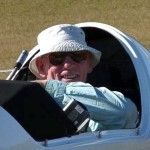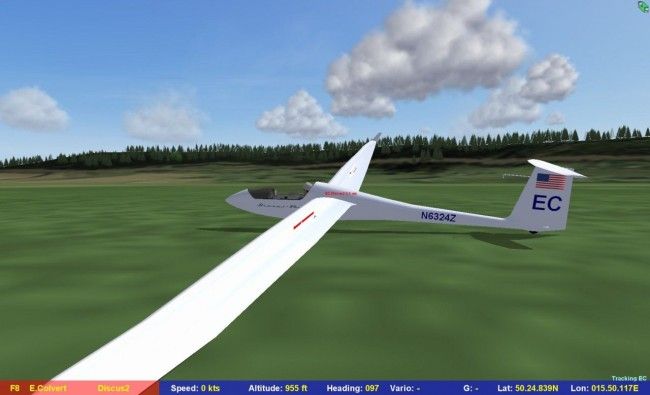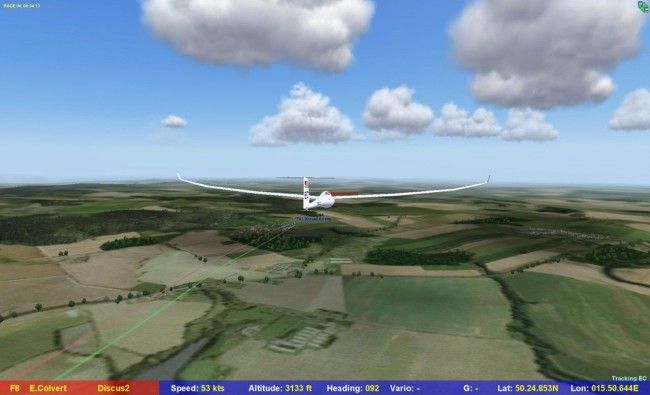Elston Colvert has a fairly new glider private pilot rating, and flies with the Sandhill Soaring Club in Michigan. So far, Elston’s cross country efforts have been limited to local flying in club gliders (the club has a Grob G-102 and one other that I can’t recall), but has several multi-hour flights, and even has an off-field landing to his credit ;-).
Elston and I hooked up last night (Thursday February 10) for a mentoring flight in Condor. I had a nice cats-cradle flatland thermal task in the beautiful Czech Republic scenery set up, and Elston had already prepared by installing P14 from the Condor site and by installing the required scenery from the Monday Night Soaring home page (http://www.gliderracing.com).
Elston called me on the telephone just at 7pm, and we got started (I like using the telephone as an open-mic intercom as it keeps the Condor audio from overpowering our voices). After some preparatory discussion about what we were going to do, I told Elston we would be flying standard-class Discus 2 ships (my real-life glider is a Schemp-Hirth Ventus 2bx, so I like using the D2), and then launched the server. When he connected and while we were hanging around in mid air (I use an air launch to avoid problems with aerotow), I gave him a brief tour of the PDA screens and explained the various values on the final glide page (these always seem to be hard to understand at first). Then we started flying around in the start area, becoming familiar with the thermals before the start.
As we tried to gain altitude, it immediately became obvious that Elston was having trouble finding the lift under the clouds, and so I had to spoiler down several times to get him into the thermal. Interestingly though, once in the lift, Elston did a very credible job of staying in the core and climbing well. If he ever figures out how to find the thermal in the first place, Elston is going to be hard to catch! ;-).
Out on course, we talked together on the ‘intercom’ about cloud selection and how to tell if a cloud is building or dying, how to maintain a straight course, and how to decide what speed to fly. When I first start out on a task, I generally use a ‘block’ speed of about 70kt in a modern standard class glider with no ballast, but instead of just saying “fly 70kt”, I had Elston set up a MC value of about half to 2/3 of our best climb, and then fly the speed-to-fly needle to center. at an MC value of about 2.5-3.0kt, the STF is about 70kt. This makes the ‘block speed’ concept used by most modern race pilots a little easier to understand.
As we got to within shouting distance of final glide, I had Elston start looking ahead using Condor’s final glide (#3) screen to see what we needed to get home, and we talked a bit about how to manage energy so that a comfortable final glide is achieved without getting so high that energy is wasted at the end.
After the flight, we stayed on the runway for a few minutes, summarizing the lessons learned from the flight, and I gave Elston some exercises to work on to improve his thermal entry skills. Hopefully we will be able to fly together at least one more time before I disappear to Florida in March to start the contest season.
Here are some screenshots from the flight
Comments from Elston: I always ask for comments (good or bad) from mentoring flight participants, and here is what I got back from Elston:
You asked that I provide a critique of the instruction in the hope that I could provide you useful feedback. I honestly don’t know what you could improve. Certainly you cannot impart to a student all there is to learn about cross-country soaring in one evening, but you did a darn good job trying (my limitations, not yours). You said, “I can not soar and talk at the same time.”, but you did an excellent job of it last night (flying circles around me while critiquing my flying, instructing, and flying the task!).
What I found somewhat difficult was just that which we talked about at the outset, flying and talking at the same time. Since I was trying to fly as best I could, it was difficult to listen, talk, understand, put in practice, and remember everything that was said. This is why I have tried to document everything you told me, and why I will follow-up with frequent practice flying Condor.
I have a couple follow-up questions just below and then below them I have tried to capture everything we talked about:
- You told me anybody can host a flight. How can I do this?
- You said to use the ‘basic’ speed of 70 kts (I believe you used a different term but I cannot recall what it was) for flying between thermals in the Discuss2. I didn’t understand how this ‘basic’ speed was determined? Is this speed dependent on the plane, the weather, both, other?
Per Frank Paynter Condor ‘flight’ instruction (please let me know if I have something incorrect)—
- Use the B and N keys for the spoilers to make sure they close completely
- The green gage in the center of the instrument panel is the flight computer—altitude is in MSL. The vario reading on this instrument is the ‘averager’ reading. The average is taken over the time interval that you set in the Condor setup page.
- The average vario reading is also shown on the PDA 4 screen. I assume this uses the same time interval for the average?
- The PDA 3 screen, DH and DDH altitude is AGL and is in reference to the current task point (current AGL above task point and projected AGL above task point at time of arrival).
- After turning the last task turn point Frank told me to change the McCready setting so as to make the projected altitude at arrival to the final turn point (ie, the DDH altitude) to 400-500ft. Then when within a two miles of the final point, change the McCready setting to make the DDH 100-200 ft. Fly speed to fly using these McCready settings.
- If you arrive at the final turn point at 1000-2000ft, you have gained too much altitude in your last thermal. This is also true if you are flying very fast, i.e., close to red line—over 110-120 kts
- Don’t stop for thermals that are below (weaker) than what you believe to be the best available (don’t stop for a 3kt thermals when you have reason to believe that there are still 6 kt thermals to work with).
- Try not to deviate very far from the task path. To do so is very costly.
- When you approach a turn point, be looking for the next source of lift along the line to the next task point.
- Rule of thumb: The modern glider can glide about 5 nautical miles per thousand feet of altitude (1000/30,000 or1:30). Best glide ratio, published data:
1. Discus2: 45 @ 51 kts
2. ASW28: 45 @ 50 kts
3. LS8: 43 @ 53kts
Additional question: You use 30 instead of 45 to be conservative—taking under consideration that the air is not still (there is both wind and sink)?
- See www.SoaringCafe.com for a blog on Condor
Things Frank recommended that I work on:
- Approaching the center of the cloud and thereby into the thermal and getting centered within one to two turns.
- Use a mouse (rather than the touch pad) to change the view through the windshield
- Watch Frank’s thermal video again
- Go back and forth between a couple of clouds in Condor to practice finding the lift and centering within 1-2 turns.
When approaching the cloud, keep looking up to center the glider on the cloud, use the H key to help at first. After getting good at this, use the H key after you feel you are centered to check how well centered you really are.
Pay attention to the appearance of clouds to try your best to pick a good one: a young cloud; a cloud with crisp definition. Avoid ragged looking clouds. Sub-optimal thermals can really slow you down.
- Contact (e-mail) Frank at the end of the month for possible additional instruction and to check on progress.
Additional Info:
Frank uses an iPaq PDA with Win Pilot. He also has a ClearNav.
Frank suggested Soaring Pilot as good free software for IGC files.
Frank owns and flies a Ventus 2 (bx?)
Elston Colvert
Sandhill Soaring , Michigan














1 comment for “Mentoring flight with Elston Colvert”